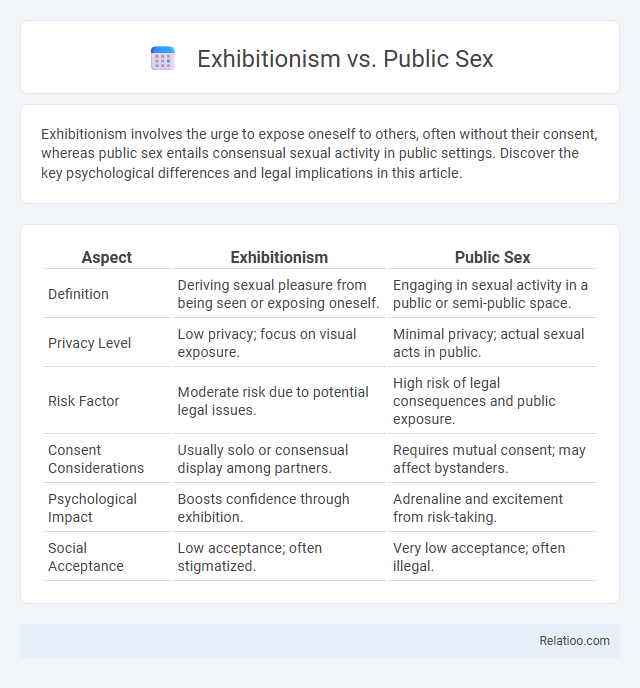Exhibitionism involves the urge to expose oneself to others, often without their consent, whereas public sex entails consensual sexual activity in public settings. Discover the key psychological differences and legal implications in this article.
Table of Comparison
| Aspect | Exhibitionism | Public Sex |
|---|---|---|
| Definition | Deriving sexual pleasure from being seen or exposing oneself. | Engaging in sexual activity in a public or semi-public space. |
| Privacy Level | Low privacy; focus on visual exposure. | Minimal privacy; actual sexual acts in public. |
| Risk Factor | Moderate risk due to potential legal issues. | High risk of legal consequences and public exposure. |
| Consent Considerations | Usually solo or consensual display among partners. | Requires mutual consent; may affect bystanders. |
| Psychological Impact | Boosts confidence through exhibition. | Adrenaline and excitement from risk-taking. |
| Social Acceptance | Low acceptance; often stigmatized. | Very low acceptance; often illegal. |
Understanding Exhibitionism: Definition and Psychology
Exhibitionism involves deriving sexual arousal from displaying one's genitals or sexual acts to unsuspecting others, differing from consensual public sex where all parties agree to participate. Understanding exhibitionism requires exploring its psychological roots, often linked to a desire for attention, thrill-seeking, or underlying mental health conditions such as impulse control disorders. If you suspect exhibitionistic tendencies, recognizing these behaviors early is crucial for seeking appropriate psychological support and ensuring safety for yourself and others.
Public Sex: Exploring Motivations and Contexts
Public sex involves engaging in sexual activity in semi-public or public spaces, drawing significant interest due to its complex motivations and social contexts. Individuals may seek the thrill of potential exposure or the excitement of breaking social norms, often driven by curiosity, exhibitionistic tendencies, or the desire for heightened arousal. Contextual factors such as location, risk perception, and anonymity heavily influence the appeal and acceptance of public sex, distinguishing it from controlled exhibitionism scenarios.
Key Differences Between Exhibitionism and Public Sex
Exhibitionism is a psychological condition characterized by the urge to expose oneself to non-consenting strangers for sexual gratification, whereas public sex involves consensual sexual activity in public spaces. Key differences include the presence of consent and intent; exhibitionism focuses on the thrill of exposure without partner consent, while public sex involves mutual participation and awareness. Legal and social consequences vary, with exhibitionism often classified as a criminal offense due to its non-consensual nature, unlike consensual public sex, which may face different legal challenges depending on the jurisdiction.
Legal Implications: Laws and Consequences
Exhibitionism, typically involving the exposure of one's genitals to unsuspecting individuals, is criminalized under laws related to indecent exposure and can result in charges ranging from misdemeanors to felonies depending on jurisdiction. Public sex, involving consensual sexual acts performed in public spaces, is also illegal in most regions, often prosecuted under public indecency or lewd conduct statutes with penalties including fines, jail time, and sex offender registry requirements. Legal consequences for both behaviors vary widely but consistently emphasize protecting public order and preventing non-consensual exposure, thereby highlighting the importance of understanding local statutes to avoid severe legal repercussions.
Consent and Boundaries in Public Sexual Behavior
Exhibitionism involves deriving sexual arousal from exposing oneself to non-consenting others, whereas public sex refers to consensual sexual activity taking place in public spaces while respecting boundaries. Consent is paramount in distinguishing these behaviors, as public sex requires mutual agreement among participants and awareness of the surrounding environment to avoid violating bystanders' rights. Understanding and respecting legal and social boundaries ensure your actions align with ethical public sexual behavior and prevent harm.
Cultural Perceptions and Societal Attitudes
Cultural perceptions of exhibitionism often vary significantly, with many societies viewing it through the lens of taboo or deviance, whereas public sex is frequently similarly stigmatized but increasingly discussed in the context of consensual adult behavior and legal boundaries. Societal attitudes toward exhibitionism prioritize notions of privacy and propriety, often categorizing it as a psychological or legal issue, while public sex can challenge norms related to public decency laws and social acceptability depending on cultural context. Distinctions between exhibitionism and public sex highlight evolving debates on personal freedom, consent, and communal standards within diverse cultural frameworks worldwide.
Potential Risks and Safety Considerations
Exhibitionism, public sex, and consensual exhibitionistic behaviors carry distinct potential risks, including legal consequences, public exposure to non-consenting bystanders, and personal safety threats. Understanding local laws regarding public indecency and ensuring clear consent from all parties involved in any public or semi-public sexual activity significantly reduce these risks. Practicing discretion, selecting safe, private locations, and communicating boundaries prioritize safety while minimizing psychological and physical harm.
Digital Exhibitionism: The Online Dimension
Digital exhibitionism transforms traditional exhibitionist impulses into online behaviors such as sharing provocative photos or engaging in live video sessions. This form differs from public sex, which involves physical acts in public spaces, by emphasizing virtual exposure and audience interaction through digital platforms. Understanding your boundaries and privacy settings is crucial to safely navigating the online dimension of exhibitionism.
Navigating Relationships and Communication
Exhibitionism involves deriving pleasure from exposing oneself to others, often in non-consensual settings, whereas public sex refers to engaging in sexual activities in public spaces, with a focus on mutual consent. Navigating relationships requires clear communication about boundaries, consent, and comfort levels to ensure all parties feel respected and safe. Understanding these distinctions helps you foster open dialogues that strengthen trust and intimacy in your relationships.
Resources and Support for Those Seeking Help
Resources for exhibitionism and public sex often overlap, offering specialized counseling, therapy groups, and online support communities tailored to address compulsive sexual behaviors and legal consequences. Mental health professionals recommend Cognitive Behavioral Therapy (CBT) and support from organizations like the Society for the Treatment of Sexual Abusers (STSA) to help manage urges and develop healthier coping strategies. You can access confidential helplines and educational materials from reputable sources to find appropriate treatment options and community support.

Infographic: Exhibitionism vs Public Sex
 relatioo.com
relatioo.com